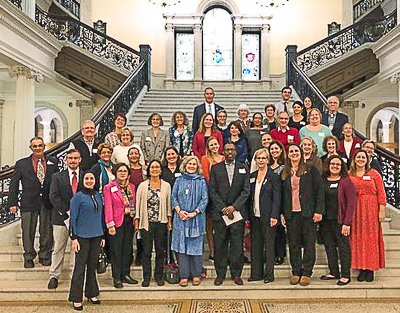Bending the Arc

Bending the Arc: Advancing Human Rights in the Commonwealth
The Massachusetts Human Rights Coalition (MAHRC) held their first annual meeting at the State House on Friday, October 12, "Bending the Arc: Advancing Human Rights in the Commonwealth."
Photo: Bending the Arc participants gather on grand staircase at State House
The lesson of the day can be stated simply,
No one is free unless we are all free.
MAHRC is an informal association of municipal human rights commissions, non-profits, and government agencies that work to promote human and civil rights and harmonious community relationships at a local level. The meeting was co-sponsored by Senator Jason Lewis and Representative Paul Brodeur.
Adam LaFrance and Neil Osborne, members of the Steering Committee of MAHRC, facilitated the meeting. Adam is the Chair of the Melrose Human Rights Commission. Neil is the Director of Diversity for Medford.
Transgender issues
Mimi Lemay
That we must all be free was most poignantly clear in the presentation of Mimi Lemay, one of the panelists speaking to "Community Organizing and Transgender Legal Protections." Mimi Lemay is the mother of three, one of whom is her son Jacob, who transitioned at the age of five. Following a very complex and sensitive situation for her and the family to negotiate, she went public about their success and happiness and has had considerable positive public response. She opened a door to our understanding and appreciation of the issue of gender identity in our times.
Lisbeth DeSelm, Alexandra Chandler, and Valerie Frias brought additional experiences and insights to the discussion.
Question 3
We also learned about the intent and meaning of Question 3 on the ballot. A "Yes" vote would continue existing legal protections for the civil rights of transgender people, a "No" vote would expose transgender people to prejudice and harm in public settings. The "No" proponents make a lot of noise about sexual predation in public bathrooms, despite the lack of evidence of any such danger since the law was passed. The impact of restricting the civil rights of a person is to create psychological harm, practical barriers to full participation in society, and to diminish them as somehow less human.
Starting a Human Rights Organization
The afternoon breakout session on "Creating a Human Rights Organization in Your Community" proved of tremendous value, because each of the panelists is experienced in starting and running a human rights group.
The panelists were:
- Stephen Bressler, who worked for Brookline in human rights for decades;
- Kathryn Bonfiglio, President of Belmont Against Racism, a non-profit group;
- Linda Snow Dockser is past chair of the Reading Human Relations Advisory Committee, and one of the founding members of Reading Embraces Diversity, the non-profit group for human rights, and is also Vice Chair of the Reading School Committee;
- and William Chetwynd, one of the founders and a current member of the Wakefield Human Rights Commission and past member and Chair of the School Committee.
One of the issues presented by Kathryn Bonfiglio was to consider the pros and cons of being part of the municipality vs. being an independent non-profit. It is not a simple choice and each situation is different. An official group has a peer relationship with other municipal departments, but may have little funding and be constrained by the rules of the open meeting law. Official groups are bound by specific requirements which, while assuring transparency, can restrict informal discussions among the members of the group; see Massachusetts Public Records Law, M.G.L. c. 66 § 10 An independent group may have some greater freedom from the concerns of elected officials and has the advantage of being able to raise funds to enable a variety of outreach activities. An official group affirms the commitment of the community, while an independent group has greater flexibility.
The first suggestion is that at this stage "human rights organization" is not the right way to promote understanding of our goals. People don't know they need "human rights." Focus on what they need and have always done: fair play for all, inclusion, respect, welcoming all. This approach reinforces our sense that we should work to enhance and build on our positive history and traditions. This can be done through the choice of names: For example, Reading created an informal group to advance human rights and called it "Reading Embraces Diversity." Another example is "Winchester Multicultural Network: Building Inclusive Community." Winchester has a film series called "One Winchester, Many Traditions..."
Engage a number of leaders including representatives of the police, schools, city council, business community, elderly, the disability community, minority groups, newcomers. Involve the Chief of Police and the Superintendent of Schools, the experience in many communities is that they will be key members of any organization---either in person or by nominating a representative. Ask the Superintendent to include youth, one or two high-school students.
The main idea was that we need to get people together in the same room and listen to each other. This can be a panel discussion and workshop, and/or a community forum.
Getting people together seems more important when starting out than deciding on an organizational format.
"Most issues can be resolved if we get together to talk," said Bill Chetwynd.
Restorative Justice
Informal discussions mentioned positive things to say about restorative justice as an alternative to court actions. One of them said they have seen positive results. And there is a legal basis for using it. We know that mediation is inappropriate where the parties may not be of equal power status. So a quiet, private and confidential setting for the resolution of grievances through restorative justice might be a good additional resource to bringing people together and creating better understanding.
Is restorative justice appropriate for resolving issues of bullying or for violations of human rights? Where has it been used and has it proved effective?
So let's explore that direction, let's see where it might be appropriate to consider. Please volunteer to form a small group to research and explore the pros and cons of restorative justice and report back to us what you learn.
I am very grateful to everyone who helped to make the gathering at the State House so informative and inspirational.
Resources
Transgender issues
http://www.wbur.org/hereandnow/2015/03/16/trans-son-letter
https://www.boston.com/culture/parenting/2015/02/26/a-letter-to-my-son-jacob-on-his-5th-birthday
Question 3
https://www.freedommassachusetts.org/learn-more/
Belmont
http://belmontagainstracism.org/#links
Restorative Justice
Communities for Restorative Justice
The mission of Communities for Restorative Justice is to provide a restorative justice option within the criminal justice system, wherein:
- Victims of crime are given the opportunity to address the people who have harmed them, ask questions in a safe environment, and help determine how the harm should be repaired.
- Offenders better understand the impact of their actions, are held meaningfully accountable, and are encouraged to make amends to those they have harmed.
- The community offers support for the process, strengthening community connections, and engaging in matters of concern to its members.
Supporters
We enjoyed a free vegetarian Egyptian lunch by Koshari Mama, a north shore catering company, and coffee was donated by the Melrose Starbucks.
Contact for MAHRC
email: masshrc@gmail.com
Facebook: www.facebook.com/MAHRCoalition
- Log in to post comments
